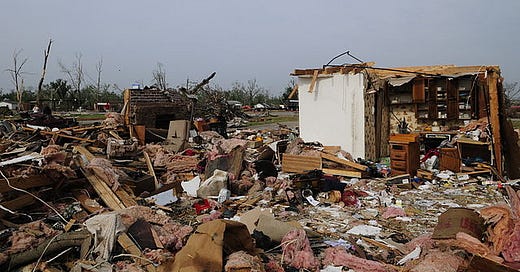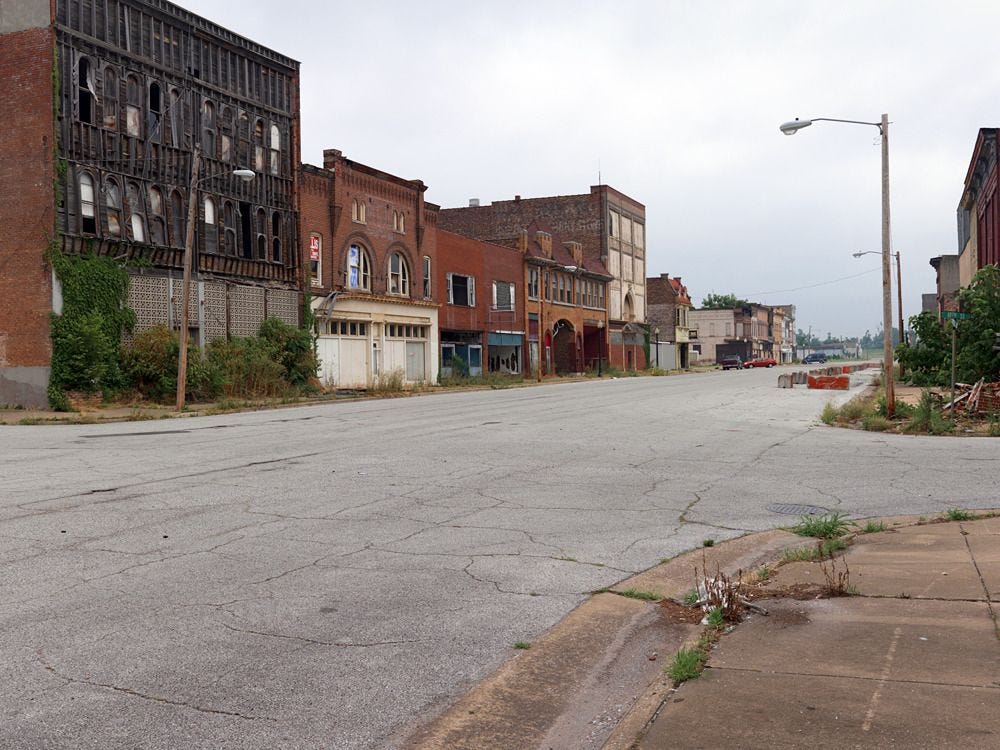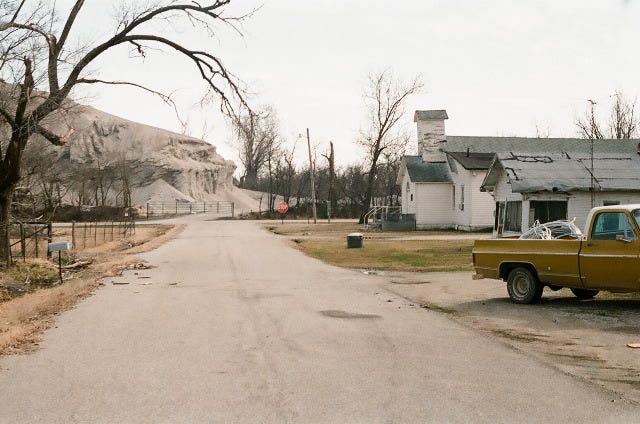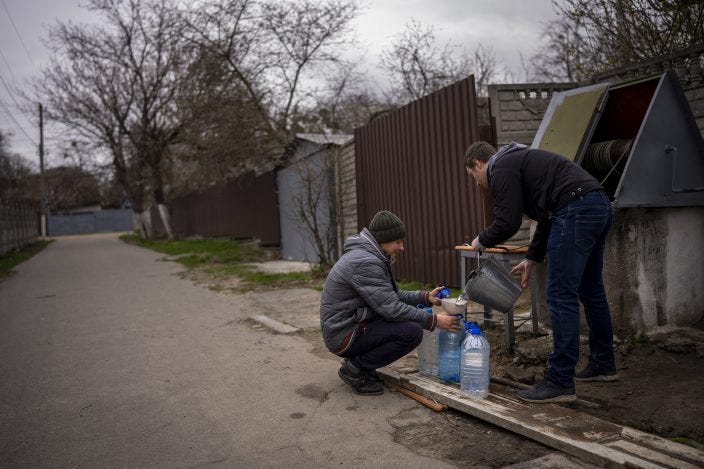Population: 20,000 inhabitants nationwide
This is the dead land
This is cactus land
Here the stone images
Are raised, here they receive
The supplication of a dead man's hand
Under the twinkle of a fading star.
Author’s Note: This is a different kind of article than the ones I’ve written so far. Going forward, this series is going to include some special topic articles covering aspects of life in the American wasteland. The goal going forward is to include a new special topic every fifth article, though we’ll see how I can keep that up.
Introduction
Perhaps the most enduring legacy of the Great War is the radiation that has seeped into the earth.
Thousands of nuclear warheads were launched or dropped on American soil, instantly killing nearly a third of the country’s population. At ground zero, little more remains than craters. Sufficiently-reinforced bunkers may have been able to withstand a nuclear blast, but many cities, military bases, and vital infrastructural centers were hit with by multiple warheads from overlapping strikes. Combined with the lethal blast of radiation, the survival rate at ground zero is effectively zero.
Further out, where the blast force lingers between 5 and 2 psi of pressure, there is a roughly 50% immediate casualty rate. From 2 to 0.5, that number drops to 25%, and physical damage ranges from very severe to light, depending on the construction. That is to say, the irradiated no-man’s-lands that are the Nuclear Exclusion Zones do not all look the same, nor are they equally poisonous to those who dwell there. Some cities are moonscapes; others look much like the abandoned, decaying suburbs and inner cities of the late 2020s, simply abandoned and left for the wilderness to reclaim.
Fallout
Radioactive fallout, of course, mars the lands it touches and generally prevents long-term habitability. In the areas surrounding the detonation craters, radiation peaked at 6,000 rads per hour; for reference, 500 rph is a lethal dose. Factors such as the make of the bomb, how high it was detonated, the weather, prevailing wind direction, the geologic makeup and topography of the area, etc. all determine the level of radiation. The level of radiation falls rapidly, given the nature of decaying particles, but does so with diminishing effects. Within just two weeks, the 6,000 rads level will wane to 6 rads—still lethal, given only three days’ exposure.
About half the fallout can be easily scrubbed away with bleach and water, but true radiation scrubbing (carried out by special protected teams by factions who care to do so) requires sandblasting and high-pressure water sprays.
Nearly thirty years have passed, and the average radiation level in the suburban outskirts of your average nuclear blast is down to below 10 rads per year. For reference, the average dose of radiation received before the war was 0.33 rads per year, meaning your typical NEZ dweller receives a year’s worth of radiation every few months.
This level is lower outside some NEZs fortunate enough to have only been struck with a single low-yield bomb. This is most common for targets from the secondary strike phase of the Third World War. Provisional capitals, like Bakersfield, California or cities that were missed in the initial wave of strikes, like Tulsa, Oklahoma are relatively (load-bearing relatively) well-off, with habitable suburbs.
The same cannot be said about the worst-off regions. These include heavily-bombarded centers like the Cheyenne Mountain Complex and Washington, D.C., melted-down nuclear reactors, nuclear missile silos that were struck with still-armed warheads trapped in the bay, and “salted” regions. The latter includes areas struck by bombs that were salted with Cobalt-60, a highly radioactive isotope with an extremely long half-life. Cobalt-salted regions are among the least habitable in the entire country, and include D.C., the country’s largest cities like New York and Los Angeles, and the now-spoiled gold reserves at Fort Knox.

Designating the NEZs
“Nuclear Exclusion Zone” is not a term that was common before the war, outside of discussions surrounding Chernobyl. It first came into common use during the Battista Administration, when Acting President Tony Battista of the Twin Falls Government enacted a policy of national triage. Rather than fight a losing battle to preserve order in the poisoned ash-lands of what was once America’s beating heart, Battista evacuated all government and military forces and called on civilians to follow them to government safe zones, the “Reconstruction and Recovery Centers.” To dissuade the people from staying behind, he instituted the Nuclear Exclusion Zones.
The zones themselves are the approximate perimeters of irradiated territory, loosely calculated from the estimated strength and conditions of the initial blast, modified by prevailing winds. Hence, some NEZs are simple circles around a destroyed city or military base, while others occupy vast swathes of abandoned countryside, stretching from state to state.

Under Battista’s direction, first responders and other authorities were prohibited from operating within the zones; any civilians left behind were on their own. Even if the authorities felt so inclined, there was little they could do to salvage the regions. In addition to the blankets of fallout was a complete lack of usable infrastructure: no electricity or running water, roads and bridges in ruin, and debris everywhere.
Though the government could do little to help them, most civilians became aware of the vague boundaries of the NEZs (if they couldn’t already tell them) thanks to the prolific distribution of a widely-publicized map. The Battista Administration accomplished very little, but the creation of the NEZs and the map to guide people away from them is generally considered the ephemeral President’s most successful and longest-lasting contribution to his country.
Life in the Zone
As implausible as it may sound, many Nuclear Exclusion Zones still harbor life. Some certainly do not—linger for an hour in downtown Los Angeles and you will die. Many adventurers hoping to grow rich off of the fabled Fort Knox gold have learned that perilous lesson. Yet the outskirts of your average NEZ are habitable enough for humans to still live in them.
Few do so. Most are only the most desperate outcasts who aren’t welcome anywhere else. Bandits, poachers, refugees, the anathematized, people cursed with forlorn hope. A handful of tiny warlords (if they can even be called such) commanding gangs in the low tens—too weak to carve out even the meanest, smallest towns outside the Zone, rule these lands as the kings of all that is worthless. On rare occasions, they can marshal enough strength to conquer some “clean” place of their own if there’s a significant enough power vacuum. Such gangs include the King of the World in Jackpot, Nevada, or the Iron Fist in Cameron, Missouri. Others who live in the NEZs are simply oddballs, or the stubborn, aging loners who can’t be parted from their original homes.
What do these people do? They live as best they can. Where there is still seed and the know-how to farm, they grow food; where there are still wild animals, they hunt. Where there are still dandelions growing the cracks of twisted concrete slabs, they gather. They fight outsiders who try to prospect for loot among the ruins, and they fight each other for ownership of said loot. Populations are generally so low that the fighting never grows serious, not even reaching the level of a gang war or a low-intensity insurgency. You’re more likely to see ambush killings, honor killings, and bride kidnappings than you are gun battles in these parts.
Even without the violence, lifespans are short. Food is always scarce, and seldom is it wholesome. The health hazards presented by radiation are self-evident; but, believe it or not, it’s not the primary check on human lifespans here. More prevalent and more deadly is industrial runoff pollution from destroyed factories, refineries, and power plants. Between the fallout and the pollution, the average lifespan is in the high thirties to low forties, and the risk of birth defects remains high.
The Future of the Zones
Although few people live in the zones and fewer still are moving into them, they remain an important facet of the American wasteland. Outsiders still frequently interact with the zones and may depend on them for their livelihoods.
The most obvious are scavengers and poachers: those who are coming to the zones to harvest whatever material bounty may still be found there. As time goes on, the scavenger population is decreasing, as there is less worthwhile treasure to recover, while the poacher population is increasing, as organized factions place tighter controls on land usage.
There is also the benefit of transport. While some zones are so lethal that even passing through them briefly kills, most are entirely safe for transit. Merchants and armies alike pass through them as shortcuts, if they need to be somewhere fast and pay little heed to danger. In fact, passing through NEZs is a necessity for most American trade routes. The major rivers of America are riddled with fallout, though the waters themselves are safer today than they were thirty years ago. Some daring captains who wish to evade the Acadian People’s Republic’s harsh restrictions on river trade will even chance to brave the perilous New Orleans Exclusion Zone by riding up the Mississippi through the Mississippi River—Gulf Outlet Canal, rather than take the safe way via the Atchafalaya River.
Larger, better-organized factions naturally have the pick of the litter when it comes to NEZ loot and travel. They can control the routes of travel and can send in organized expeditions with protective gear to take the best there is left to find; this is especially the case in NEZs that are entirely surrounded by a single faction’s territory, such as Little Rock, Arkansas or Lincoln, Nebraska. The best-off might have semi-permanent bases and relay stations for their salvage teams, and regular patrols to protect the merchant caravans from NEZ bandits. Soldiers stationed in NEZs for too long, however, have a tendency to mutiny or desert, and smart leaders are careful to regularly rotate the men out and pay them handsomely for the trouble. Between the costly payrolls and having to import all supplies and equipment from elsewhere, this makes NEZ reclamation an extremely expensive endeavor that only a few factions are able to support.
Despite the tantalizing prospect, very few factions have made any real attempts at reclaiming the NEZs, scrubbing out the fallout, and permanently settling them. In most cases, the radiation level simply isn’t low enough yet that it would be economically viable, although it’s getting there. Factions that are okay with losing money on the venture can afford to reclaim NEZs as prestige projects; the most noteworthy example is the Elizabeth City naval government’s “Plymouth Reclamation Zone” in Plymouth, Massachusetts. Inhabiting one of the first sites of English settlement in America and reclaiming the famous Plymouth Rock is a major point of pride for the Elizabeth City government.
By current estimates, it’s thought that the average NEZ will become economically viable to clean up and resettle by the late 2080s. While normal fission byproduct radiation will not fall below background levels for several hundred thousand years, it will drop below 1 rad per year at ground zero locations by the 2130s. Cobalt-60 radiation will fall below background levels by the 2160s, and will become viable for reclamation some time in the early 22nd Century.
Index
Click here to read the master post of the series, with links at the bottom of the page to all other Fallen Continent entries.
Previous Entry: Oregon
Next Entry: California








Everything is perfect. I'm excited for the religion article.